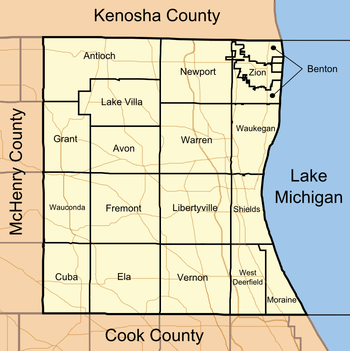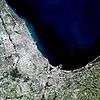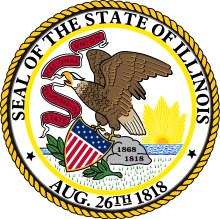Lake County, Illinois
Lake County is a county situated in the northeastern corner of the U.S. state of Illinois along the shores of Lake Michigan. According to the 2010 census, it has a population of 703,462,[1] making it the third-most populous county in Illinois after nearby Cook and DuPage Counties. Its county seat is Waukegan, the ninth-largest city in Illinois.[2] Due to its location, immediately north of Chicago’s Cook County, Lake County is one of the collar counties of the Chicago metropolitan area.
Lake County | |
|---|---|
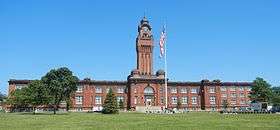  | |
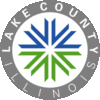 Seal Logo | |
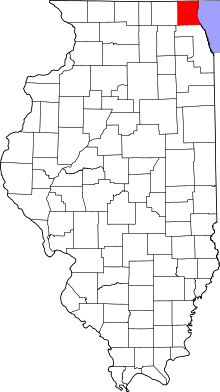 Location within the U.S. state of Illinois | |
 Illinois's location within the U.S. | |
| Coordinates: 42°26′N 87°47′W | |
| Country | |
| State | |
| Founded | March 1, 1839 |
| Named for | Lake Michigan |
| Seat | Waukegan |
| Largest city | Waukegan |
| Area | |
| • Total | 1,368 sq mi (3,540 km2) |
| • Land | 444 sq mi (1,150 km2) |
| • Water | 925 sq mi (2,400 km2) 67.6% |
| Population (2010) | |
| • Total | 703,462 |
| • Estimate (2019) | 696,535 |
| • Density | 510/sq mi (200/km2) |
| Time zone | UTC−6 (Central) |
| • Summer (DST) | UTC−5 (CDT) |
| Congressional districts | 6th, 10th, 14th |
| Website | www |
According to the 2010 census, Lake County is the second most wealthy county in Illinois by per capita income, after DuPage County. Additionally, Lake County ranks as the 27th wealthiest county in the nation. The lakefront communities of Lake Forest, Lake Bluff, and Highland Park are part of the affluent North Shore area.
Naval Station Great Lakes is located in the city of North Chicago. It is the United States Navy's Headquarters Command for training, and the Navy's only recruit training center.
History
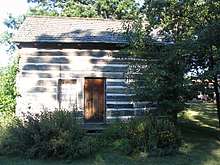
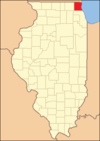
The county, which was primarily unsettled prairie and was still home to its native Potawatomi Indians, was created by the Illinois State Legislature in 1839. At that time, Libertyville, then known as Independence Grove, was the first county seat. In 1841, however, the county's residents voted to move the county government to Little Fort, now Waukegan, where the commissioners had purchased a section of land from the state. Lake County's first courthouse was built on part of that land in 1844 and the remainder was sold to pay for the $4,000 construction cost.
The county's first courthouse was used solely for court sessions and the jail, but in 1853, commissioners constructed a building to accommodate county administration offices and house records. When fire damaged the courthouse on October 19, 1875, the county records were saved because they were in the adjacent building.
After the fire, proposals were made to move the county seat to Highland Park, Libertyville or another site in central Lake County. The county commissioners, however, decided to rebuild in Waukegan. The east half of the building was reconstructed at a cost of $45,000. In 1895, the first jail building was added to the government complex and a west addition was added to the courthouse in 1922. By 1938, county commissioners saw a need for additional space and approved the addition of a 5th Floor. This courthouse, however, was demolished in 1967 to make room for a new high-rise administration building, which was completed with the addition of the jail in 1969 and courts in 1970.
Shortly thereafter, the Lake County Board commissioned the construction of a multi-faceted justice facility and ground was broken in 1986 for the Robert H. Babcox Justice Center, named in memory of Sheriff Babcox, who served as Lake County Sheriff from 1982–1988. The justice center, which houses the county jail, work release program, sheriff's administration offices and three courtrooms, was finished in 1989 at a cost of $29.6 million.
Additional county government facilities have been built or expanded throughout Lake County, including the Coroner's Office, Health Department/Community Health Center facilities, Division of Transportation, Public Works and Winchester House. Lake County government services extend throughout the county's 470 square miles (1,200 km2).
The historic Half Day Inn, a tavern/restaurant, was constructed in 1843. This structure, once located at the corner of Milwaukee Avenue and Rte. 45/Old Half Day Road, was one of the oldest structures in Lake County until it was demolished in 2007 to make way for retail space, condominiums, and a retention pond.
Geography

According to the U.S. Census Bureau, the county has a total area of 1,368 square miles (3,540 km2), of which 444 square miles (1,150 km2) is land and 935 square miles (2,420 km2) (67.6%) is water.[3] It is the second-largest county in Illinois by total area and the only one that has more water area than land area. Most of the water is in Lake Michigan.
State parks
Lakes
Besides Lake Michigan, lakes in the county include:
- Lake Amy
- Antioch Lake
- Ashley Lake
- Bangs Lake
- Lake Barrington
- Benet Lake
- Big Bear Lake
- Bluff Lake
- Brandenburg Lake
- Bresen Lake
- Butler Lake
- Lake Catherine
- Cedar Lake
- Channel Lake
- Lake Charles
- Countryside Lake
- Crooked Lake
- Davlins Pond
- Dead Lake
- Deep Lake
- Deer Lake
- Diamond Lake
- Druce Lake
- Duck Lake
- Dunns Lake
- East Loon Lake
- Echo Lake
- Lake Eleanor
- Elmwood Farms Lake
- Lake Fairfield
- Fish Lake
- Forest Lake
- Fourth Lake
- Fox Lake
- Gages Lake
- Lake Germaine
- Grandwood Lake
- Grass Lake
- Grassy Lake
- Grays Lake
- Harvey Lake
- Hastings Lake
- Hendrick Lake
- Highland Lake
- Honey Lake
- Homer White Lake
- Huntley Lake
- Island Lake
- Independence Grove
- Lambs Lake
- Leo Lake
- Liberty Lake
- Lake Linden
- Little Bear Lake
- Loch Lomond
- Long Lake
- Loon Lake
- Lake Louise
- Lucky Lake
- Manor Lake
- Miltmore Lake
- Minear Lake
- Mud Lake
- Lake Naomi
- Nippersink Lake
- North Tower Lake
- Petite Lake
- Pistakee Lake
- Lake Potomac
- Redhead Lake
- Redwing Slough Lake
- Round Lake
- Saint Marys Lake
- Sand Lake
- Sand Pond
- Schreiber Lake
- Shady Lane Resort Lake
- Lake Sheree
- Silver Lake
- Slocum Lake
- Slough Lake
- Spring Lake
- Sterling Lake
- Sullivan Lake
- Sun Lake
- Sylvan Lake
- Third Lake
- Timber Lake
- Turner Lake
- Twin Lakes
- Valley Lake
- Waterford Lake
- White Lake
- Wooster Lake
- Lake Zurich
Natural areas
Lake County's forest preserves and natural areas are administered by the Lake County Forest Preserves district. These facilities include traditional nature preserves, such as the Ryerson Conservation Area, as well as golf courses and historic homes, such as the Adlai Stevenson historic home.[4] A long north–south string of the preserves in Lake County, including Half Day Woods, Old School Forest Preserve, Independence Grove, and Van Patten Woods, form the Des Plaines River Greenway, which contains the Des Plaines River Trail, a popular place for walking, running, and biking. Lake County is also home to Illinois Beach State Park, featuring over six miles of Lake Michigan shoreline, as well as dune areas, wetlands, prairie, and black oak savanna. Several local environmental groups operate in Lake County, such as Conserve Lake County and Citizens for Conservation, working to improve habitat. Volunteer opportunities also exist with the Lake County Forest Preserve District.[5]
Adjacent counties
- Kenosha County, Wisconsin - north
- Cook County - south
- McHenry County - west
Major highways

- Interstate 41


















Demographics
.svg.png)
| Historical population | |||
|---|---|---|---|
| Census | Pop. | %± | |
| 1840 | 2,634 | — | |
| 1850 | 14,226 | 440.1% | |
| 1860 | 18,257 | 28.3% | |
| 1870 | 21,014 | 15.1% | |
| 1880 | 21,296 | 1.3% | |
| 1890 | 24,235 | 13.8% | |
| 1900 | 34,504 | 42.4% | |
| 1910 | 55,058 | 59.6% | |
| 1920 | 74,285 | 34.9% | |
| 1930 | 104,387 | 40.5% | |
| 1940 | 121,094 | 16.0% | |
| 1950 | 179,097 | 47.9% | |
| 1960 | 293,656 | 64.0% | |
| 1970 | 382,638 | 30.3% | |
| 1980 | 440,372 | 15.1% | |
| 1990 | 516,418 | 17.3% | |
| 2000 | 644,356 | 24.8% | |
| 2010 | 703,462 | 9.2% | |
| Est. 2019 | 696,535 | [6] | −1.0% |
| U.S. Decennial Census[7] 1790-1960[8] 1900-1990[9] 1990-2000[10] 2010-2019[1] | |||
As of the 2010 Census, there were 703,462 people, 241,712 households, and 179,428 families residing in the county.[11] The population density was 1,585.6 inhabitants per square mile (612.2/km2). There were 260,310 housing units at an average density of 586.7 per square mile (226.5/km2).[3] The racial makeup of the county was 75.1% white, 7.0% black or African American, 6.3% Asian, 0.5% American Indian, 8.5% from other races, and 2.6% from two or more races. Those of Hispanic or Latino origin made up 19.9% of the population.[11] In terms of ancestry, 20.5% were German, 12.9% were Irish, 9.4% were Polish, 6.9% were Italian, 6.5% were English, and 4.0% were American.[12]
Of the 241,712 households, 40.8% had children under the age of 18 living with them, 59.6% were married couples living together, 10.4% had a female householder with no husband present, 25.8% were non-families, and 21.5% of all households were made up of individuals. The average household size was 2.82 and the average family size was 3.31. The median age was 36.7 years.[11] The median income for a household in the county was $78,948 and the median income for a family was $91,693. Males had a median income of $62,042 versus $44,200 for females. The per capita income for the county was $38,120. About 4.8% of families and 7.0% of the population were below the poverty line, including 9.6% of those under age 18 and 5.6% of those age 65 or over.[13]
2018 American Community Survey
According to the 2018 US Census Bureau estimates, the population of Lake County, Illinois was 74.1% White (60.9% Non-Hispanic White and 13.2% Hispanic White), 6.6% Black or African American, 8.1% Asian, 0.5% Native American and Alaskan Native, 0.1% Pacific Islander, 7.8% Some Other Race, and 2.1% from two or more races.[14] The White population continues to remain the largest racial category as Hispanics in Lake County primarily identify as White (60.0%) with others identifying as Some Other Race (33.9%), Multiracial (3.6%), Black (1.2%), American Indian and Alaskan Native (1.1%), Asian (0.4%), and Hawaiian and Pacific Islander (0.1%).[14] By ethnicity, 22.2% of the total population is Hispanic-Latino (of any race) and 77.8% is Non-Hispanic (of any race). If treated as a separate category, Hispanics are the largest minority group in group in Lake County, Illinois.[14]
Sports
The following sports teams play in Lake County:
- Lake County Fielders baseball (defunct)
- Lake County Coyotes baseball
Sites of interest
Amusement parks
Museums
- Volo Auto Museum in Volo, Illinois
- Lake County Discovery Museum in Libertyville, Illinois
- Warbird Heritage Foundation in Waukegan, Illinois
- Waukegan History Museum in Waukegan, Illinois
- Raupp Museum in Buffalo Grove, IL
- Shiloh House in Zion, IL
- Fort Hill Memorial Museum in Mundelein, IL
- Dunn Museum in Libertyville, IL
Performing arts
- ArtWauk in Waukegan, Illinois
- Clockwise Theatre in Waukegan, Illinois
- Genesee Theatre in Waukegan, Illinois
- Marriott Theatre in Lincolnshire, Illinois
- Ravinia Festival in Highland Park, Illinois
Other
- Naval Station Great Lakes
- Gurnee Mills shopping mall
- Lake Michigan
Communities
Villages
- Antioch
- Bannockburn
- Barrington
- Barrington Hills (part)
- Beach Park
- Buffalo Grove (part)
- Deerfield
- Deer Park
- Fox Lake
- Fox River Grove
- Grayslake
- Green Oaks
- Gurnee
- Hainesville
- Hawthorn Woods
- Indian Creek
- Island Lake
- Kildeer
- Lake Barrington
- Lake Bluff
- Lake Villa
- Lake Zurich
- Lakemoor (mostly)
- Libertyville
- Lincolnshire
- Lindenhurst
- Long Grove
- Mettawa
- Mundelein
- North Barrington
- Old Mill Creek
- Port Barrington
- Riverwoods
- Round Lake
- Round Lake Beach
- Round Lake Heights
- Round Lake Park
- Third Lake
- Tower Lakes
- Vernon Hills
- Volo
- Wadsworth
- Wauconda
- Wheeling (part)
- Winthrop Harbor
Census-designated places
Unincorporated communities
- Aptakisic
- Diamond Lake
- Fort Sheridan
- Fremont Center
- Gilmer
- Grass Lake
- Ingleside
- Ivanhoe
- Kennedy
- Loon Lake
- Millburn
- Monaville
- Palm Beach
- Prairie View
- Rondout (Part of Lake Bluff)
- Rosecrans
- Russell
- Sylvan Lake
- West Miltmore
- Wildwood
- Wooster Lake
Government
| Lake County Board | ||
|---|---|---|
| District | Board Member | Party |
| 1 | Linda Pederson | Republican |
| 2 | Diane Hewitt | Democratic |
| 3 | Dick Barr | Republican |
| 4 | Brent Paxton | Republican |
| 5 | Judy Martini | Republican |
| 6 | John Wasik | Democratic |
| 7 | Steve Carlson | Republican |
| 8 | Bill Durkin | Democratic |
| 9 | Mary Ross Cunningham | Democratic |
| 10 | Jessica Vealitzek | Democratic |
| 11 | Paul Frank | Democratic |
| 12 | S. Michael Rummel | Republican |
| 13 | Sandy Hart, Chairman | Democratic |
| 14 | Angelo D. Kyle | Democratic |
| 15 | Jennifer Clark | Democratic |
| 16 | Terry Wilke | Democratic |
| 17 | Michael Danforth | Republican |
| 18 | Julie Simpson | Democratic |
| 19 | Craig Taylor | Republican |
| 20 | Adam R. Didech | Democratic |
| 21 | Ann B. Maine | Republican |
Politics
As a historic Yankee settlement, Lake County was initially a stronghold of the Free Soil Party. In the 1848 presidential election, it was Free Soil nominee and former President Martin van Buren’s strongest county, giving him over 58 percent of the vote.
Consequently, Lake County would turn rock-solid Republican for most of the next century and a half. After narrowly supporting Democrat Franklin Pierce in 1852, it voted Republican at all but one presidential election from 1856 to 1960. This tradition was only broken in 1912, when the GOP was mortally divided and Lake County voted for Progressive Party nominee and former President Theodore Roosevelt over conservative incumbent William Howard Taft.
In 1964 the Republican Party nominated Barry Goldwater, whose hostility to the Yankee establishment and strongly conservative platform were sufficient to leave many traditional Republicans to stay home or even to vote for Lyndon Johnson, who narrowly became the first Democrat to win an absolute majority in the county since James K. Polk in 1844, and the first to win it at all since Pierce in 1852. Between 1968 and 1988, however, Lake County became powerfully Republican once more, with no Democrat cracking forty percent of the vote.
However, as in the other collar counties, the Republican edge narrowed considerably in the 1990s, and Bill Clinton actually won it with a 166-vote plurality in 1996–the only time that Clinton won one of the collar counties during his two campaigns for president. After narrowly voting for George W. Bush twice, in 2008 it swung over dramatically to support Democrat and then-Illinois Senator Barack Obama, who carried it by almost 20 points. Obama won it but by a slimmer margin in 2012. Hillary Clinton won it handily in 2016, tallying her second-best margin in the state. At 36%, Donald Trump's performance in the county was the lowest of any Republican Presidential nominee since 1912.
Lake County has the highest payout for wrongful conviction in the United States. Juan Rivera was awarded $20 million, the largest wrongful conviction settlement in United States history, including $2 million from John E. Reid & Associates, who were known for the Reid technique of questioning suspects. This technique has been widely criticized for its history of eliciting confessions that were later determined to be false. Rivera was questioned twice at Reid headquarters by an employee of the company during his interrogation, which lasted for several days. Another payout was made to Jerry Hobbs. Kathleen Zellner settled Jerry Hobbs civil rights case for $7,750,000.00. Hobbs was incarcerated for 66 months. This was the largest pre-trial detainee settlement in the United States.[15]
| Year | Republican | Democratic | Third parties |
|---|---|---|---|
| 2016 | 36.2% 109,767 | 56.4% 171,095 | 7.5% 22,658 |
| 2012 | 45.1% 129,764 | 53.5% 153,757 | 1.4% 3,972 |
| 2008 | 39.5% 118,545 | 59.1% 177,242 | 1.4% 4,113 |
| 2004 | 50.5% 139,081 | 48.8% 134,352 | 0.7% 1,862 |
| 2000 | 50.0% 120,988 | 47.5% 115,058 | 2.5% 6,118 |
| 1996 | 45.5% 93,149 | 45.6% 93,315 | 8.9% 18,300 |
| 1992 | 44.2% 99,000 | 36.5% 81,693 | 19.3% 43,294 |
| 1988 | 63.5% 114,115 | 35.8% 64,327 | 0.7% 1,191 |
| 1984 | 68.4% 118,401 | 31.1% 53,947 | 0.5% 876 |
| 1980 | 58.5% 96,350 | 29.3% 48,287 | 12.3% 20,216 |
| 1976 | 60.3% 92,231 | 37.8% 57,741 | 1.9% 2,922 |
| 1972 | 65.8% 92,052 | 33.9% 47,416 | 0.3% 344 |
| 1968 | 56.6% 68,999 | 35.6% 43,409 | 7.8% 9,495 |
| 1964 | 48.4% 58,840 | 51.6% 62,785 | 0.0% 42 |
| 1960 | 59.0% 67,809 | 40.9% 46,941 | 0.1% 149 |
| 1956 | 67.3% 66,781 | 32.5% 32,279 | 0.1% 129 |
| 1952 | 62.8% 54,929 | 37.0% 32,353 | 0.2% 145 |
| 1948 | 63.3% 39,456 | 35.6% 22,192 | 1.2% 720 |
| 1944 | 58.2% 35,674 | 41.5% 25,453 | 0.3% 183 |
| 1940 | 60.3% 38,242 | 39.3% 24,965 | 0.4% 254 |
| 1936 | 51.3% 27,548 | 45.7% 24,524 | 3.0% 1,603 |
| 1932 | 50.9% 23,994 | 44.9% 21,139 | 4.2% 1,989 |
| 1928 | 67.7% 26,814 | 31.0% 12,252 | 1.3% 521 |
| 1924 | 75.5% 18,229 | 8.3% 2,008 | 16.2% 3,913 |
| 1920 | 82.3% 15,712 | 12.2% 2,321 | 5.6% 1,063 |
| 1916 | 67.0% 12,905 | 28.3% 5,447 | 4.8% 924 |
| 1912 | 21.6% 2,183 | 24.1% 2,436 | 54.3% 5,494 |
| 1908 | 68.2% 6,392 | 24.1% 2,264 | 7.7% 723 |
| 1904 | 77.1% 6,635 | 18.5% 1,592 | 4.4% 378 |
| 1900 | 67.7% 5,136 | 29.5% 2,235 | 2.9% 217 |
| 1896 | 72.5% 5,027 | 25.6% 1,777 | 1.9% 133 |
| 1892 | 57.2% 2,932 | 38.3% 1,964 | 4.5% 233 |
Notable people
- Jack Benny (February 14, 1894 – December 26, 1974) – entertainer, comedian, actor and musician, Benny was one of America's greatest stars of radio and television, and also appeared in many films; he was raised in Waukegan, Illinois.
- Charles Boyce (September 21, 1949) – cartoonist, creator of syndicated comic panel Compu-toon and the telecommunication public affairs image The KeyPad Kid.
- Ray Bradbury (August 22, 1920 – June 5, 2012) – fantasy, horror, science fiction, and mystery writer. Best known for his dystopian novel Fahrenheit 451 and The Martian Chronicles, Bradbury is widely considered one of the greatest and most popular American writers of speculative fiction of the twentieth century. Bradbury was born in Waukegan.
- Marlon Brando (April 3, 1924 – July 1, 2004) actor; as a young sex symbol, he is best known for his roles in A Streetcar Named Desire, On the Waterfront and Guys and Dolls. Brando and his family moved to Libertyville, Illinois where he lived from 1937 until 1942.
- Timothy Selz (born September 19, 1978) - respected dietician, famous restauranteur and inventor/designer of Helix Software. Selz was born in Waukegan and his family resided in Libertyville from 1992 to 2004. In 1992-1993, Selz was a spectacular prep athlete starting on the freshman teams at Carmel High School.
- Gary Coleman (February 8, 1968 – May 28, 2010) – actor, known for his role as Arnold Jackson in the American sitcom Diff'rent Strokes (1978–1986). Coleman was born in Zion, Illinois.
- Ron Goldman (July 2, 1968 – June 12, 1994), who was killed along with Nicole Brown Simpson grew up in Buffalo Grove.
- Michael Jordan (born February 17, 1963) – retired professional basketball player and active businessman, widely considered one of the greatest players of all time; as of 2015, Jordan had a residence in Highland Park, Illinois.
- Juan Rivera (October 31, 1972) - Waukegan man who was wrongfully convicted of the 1992 murder of 11-year-old Holly Skater. After his exoneration, he was awarded US$20 million—the largest settlement for a wrongful conviction in US history.
- Vince Vaughn (born March 28, 1970) – actor, known for his roles in Swingers and Wedding Crashers; grew up in Buffalo Grove, Illinois, then moved to Lake Forest, Illinois, where he graduated from Lake Forest High School in 1988.
- Pete Wilson (born August 23, 1933), Mayor of San Diego (1971-1983); United States Senator from California (1983-1991); and Governor of California (1991-1999), born in Lake Forest.[17]
- Thomas E. Wilson (1868-1958), businessman and founder of 'Wilson Sporting Goods', resident and buried in Lake County.
- David Dobrik (born July 23, 1996), YouTube personality and actor; raised in Vernon Hills.[18][19]
See also
References
Citations
- "State & County QuickFacts". United States Census Bureau. Archived from the original on June 29, 2011. Retrieved July 6, 2014.
- "Find a County". National Association of Counties. Archived from the original on May 31, 2011. Retrieved June 7, 2011.
- "Population, Housing Units, Area, and Density: 2010 - County". United States Census Bureau. Archived from the original on February 13, 2020. Retrieved July 12, 2015.
- "Lake County Forest Preserves". Archived from the original on June 21, 2010.
- "Restoration workdays". Lake County. Archived from the original on January 6, 2014. Retrieved January 5, 2014.
- "Population and Housing Unit Estimates". Retrieved March 26, 2020.
- "U.S. Decennial Census". United States Census Bureau. Retrieved July 6, 2014.
- "Historical Census Browser". University of Virginia Library. Archived from the original on August 11, 2012. Retrieved July 6, 2014.
- "Population of Counties by Decennial Census: 1900 to 1990". United States Census Bureau. Archived from the original on April 24, 2014. Retrieved July 6, 2014.
- "Census 2000 PHC-T-4. Ranking Tables for Counties: 1990 and 2000" (PDF). United States Census Bureau. Archived (PDF) from the original on December 18, 2014. Retrieved July 6, 2014.
- "DP-1 Profile of General Population and Housing Characteristics: 2010 Demographic Profile Data". United States Census Bureau. Archived from the original on February 13, 2020. Retrieved July 12, 2015.
- "DP02 SELECTED SOCIAL CHARACTERISTICS IN THE UNITED STATES – 2006-2010 American Community Survey 5-Year Estimates". United States Census Bureau. Archived from the original on February 13, 2020. Retrieved July 12, 2015.
- "DP03 SELECTED ECONOMIC CHARACTERISTICS – 2006-2010 American Community Survey 5-Year Estimates". United States Census Bureau. Archived from the original on February 13, 2020. Retrieved July 12, 2015.
- "B03002 HISPANIC OR LATINO ORIGIN BY RACE - Lake County, Illinois - 2018 American Community Survey 1-Year Estimates". U.S. Census Bureau. July 1, 2018. Retrieved November 25, 2019.
- https://www.thenationaltriallawyers.org/2014/03/7-75-settlement-father-wrongly-jailed-murder/
- Leip, David. "Dave Leip's Atlas of U.S. Presidential Elections". uselectionatlas.org. Archived from the original on March 23, 2018. Retrieved May 8, 2018.
- "Pete Wilson". www.nndb.com. Archived from the original on September 1, 2017. Retrieved May 8, 2018.
- https://www.biographyarchive.com/david-dobrik-biography-net-worth-and-height.html
- https://www.youtube.com/watch?v=m4PW6O7oKHQ
General sources
- Forstall, Richard L. (editor) (1996). Population of states and counties of the United States: 1790 to 1990 : from the twenty-one decennial censuses. United States Department of Commerce, Bureau of the Census, Population Division. ISBN 0-934213-48-8.CS1 maint: extra text: authors list (link)
External links
| Wikimedia Commons has media related to Lake County, Illinois. |
- Lake County official government website
- Lake County Convention & Visitors Bureau
- Lake County Forest Preserve District
.jpg)

